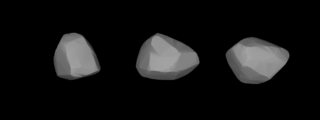Related Research Articles

Eurynome is a quite large and bright main-belt asteroid composed of silicate rock. Eurynome was discovered by J. C. Watson on September 14, 1863. It was his first asteroid discovery and is named after one of the many Eurynomes in Greek mythology. It is orbiting the Sun with a period of 3.82 years and has a rotation period of six hours. This is the eponymous member of a proposed asteroid family with at least 43 members, including 477 Italia and 917 Lyka.

Cyrene, minor planet designation 133 Cyrene, is a fairly large and very bright main-belt asteroid that was discovered by J. C. Watson on 16 August 1873 in Ann Arbor, Michigan, and named after Cyrene, a nymph, daughter of king Hypseus and beloved of Apollo in Greek mythology. It is classified as an S-type asteroid based upon its spectrum. It is listed as a member of the Hecuba group of asteroids that orbit near the 2:1 mean-motion resonance with Jupiter.

Brasilia is a large Main belt asteroid that was discovered by French astronomer Auguste Charlois on 20 May 1890 in Nice. It is the namesake of the Brasilia family, a smaller asteroid family of X-type asteroids in the outer main-belt. However, Brasilia is a suspected interloper in its own family.

Campania is a large main belt asteroid that was discovered by French astronomer Auguste Charlois on 20 September 1893 in Nice.
Mathesis is a main-belt asteroid that was discovered by German astronomer Friedrich Karl Arnold Schwassmann on March 28, 1900. Its provisional name was 1900 FC.
Alekto is a main-belt asteroid. It was discovered by Max Wolf on January 13, 1901. Its provisional name was 1901 FW. It is named for Alecto from Greek Mythology.

Laura is Main-belt asteroid discovered on 9 January 1901 by Max Wolf at Heidelberg. The semi-major axis of the orbit of 467 Laura lies just inside the 7/3 Kirkwood gap, located at 2.95 AU. It's named after the character Laura from Amilcare Ponchielli's opera La Gioconda.
Kilia is a 27 km main-belt asteroid discovered on 21 April 1901 by Luigi Carnera at Heidelberg, the 470th asteroid discovered. It was one of the 16 asteroid discoveries made by Carnera.

Papagena is an asteroid that was discovered by German astronomer Max Wolf on 7 June 1901. Its provisional name was 1901 GN.
Roma is an asteroid. It was discovered by Luigi Carnera on July 11, 1901. Its provisional name was 1901 GP. This asteroid was named by Antonio Abetti for the city of Rome in Italy, the native country of its discoverer.
Nolli is a rather small asteroid that may be in the Eunomia family. It was discovered by Max Wolf on February 13, 1901, but only observed for 1 month so it became a lost asteroid for many decades. It was recovered in 1987, 86 years after its discovery.
Prudentia is a Main-belt asteroid discovered on 13 February 1901 by Max Wolf at Heidelberg.
Ocllo is a large Mars-crossing asteroid. It was discovered by American astronomer DeLisle Stewart on August 14, 1901 and was assigned a provisional name of 1901 HN.
Hedwig is a main-belt asteroid discovered on August 17, 1901, by Luigi Carnera at Heidelberg. Named in honour of the wife of Swedish-Danish astronomer Elis Strömgren.
Caprera is a minor planet orbiting the Sun.
Emita is a minor planet orbiting the Sun that was discovered by the Italian astronomer Luigi Carnera on February 12, 1902. The meaning of the asteroid's proper name remains unknown.
Brixia is a relatively large minor planet, specifically an asteroid orbiting mostly in the asteroid belt that was discovered by American astronomer Raymond Smith Dugan on January 10, 1904. The name derives from Brixia, the ancient name of the Italian city of Brescia.

Senta is a minor planet orbiting the Sun that was discovered by German astronomer Max Wolf on 16 November 1904, from Heidelberg.
937 Bethgea is a background asteroid from the inner region of the asteroid belt. It was discovered on 12 September 1920 by German astronomer Karl Wilhelm Reinmuth, from Heidelberg.
6144 Kondojiro (1994 EQ3) is an asteroid discovered on March 14, 1994 by Kin Endate and Kazuro Watanabe at the Kitami Observatory in eastern Hokkaidō, Japan. It is named after Jiro Kondo, a Japanese Egyptologist and professor of archaeology at Waseda University.
References
- ↑ "Italy, Italia". Merriam-Webster.com Dictionary .
- ↑ Yeomans, Donald K., "477 Italia", JPL Small-Body Database Browser, NASA Jet Propulsion Laboratory , retrieved 9 May 2016.
- ↑ Buchheim, Robert K. (June 2006), "Photometry of asteroids 133 Cyrene, 454 Mathesis, 477 Italia, and 2264 Sabrina", Astronomy and Astrophysics Supplement Series, vol. 33, no. 2, pp. 29–30, Bibcode:2006MPBu...33...29B.